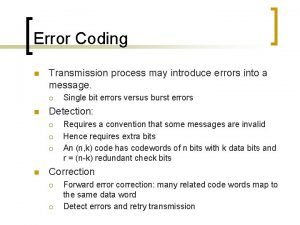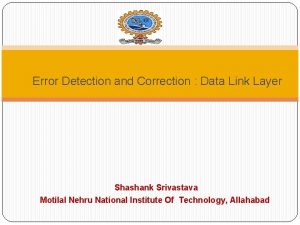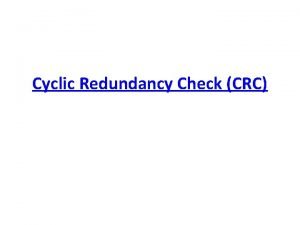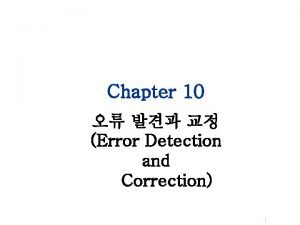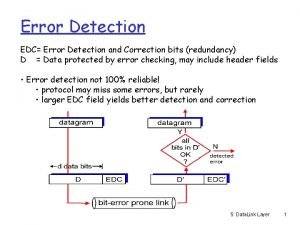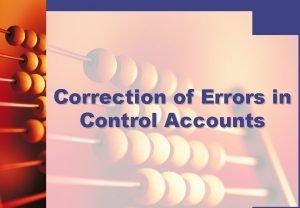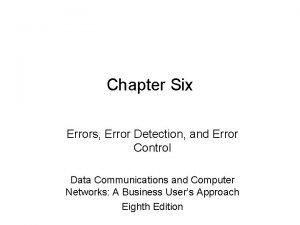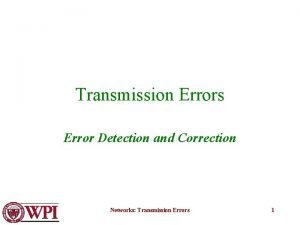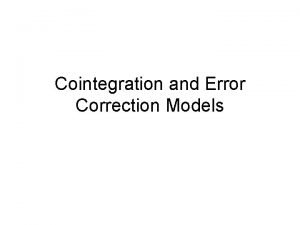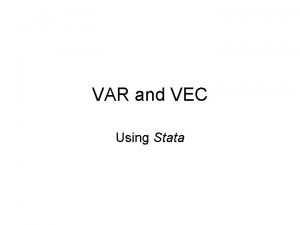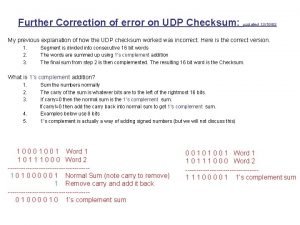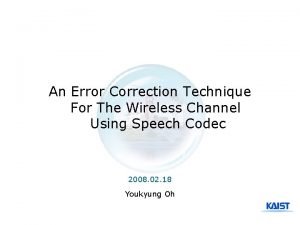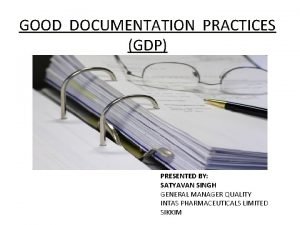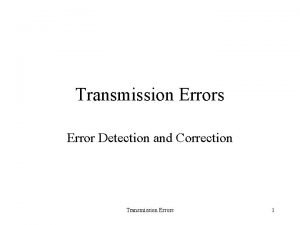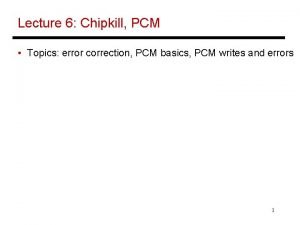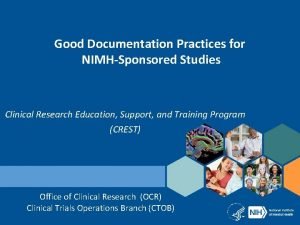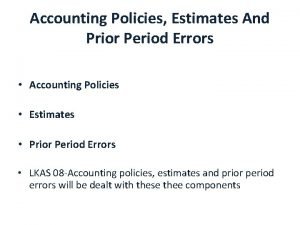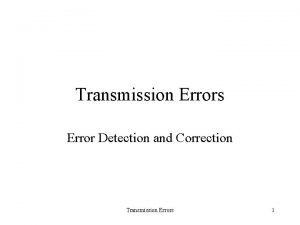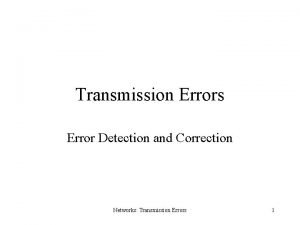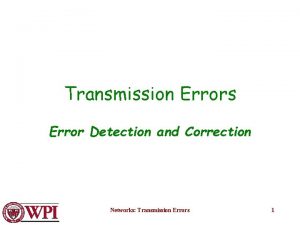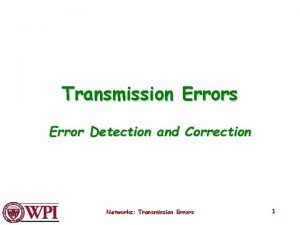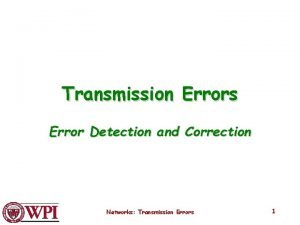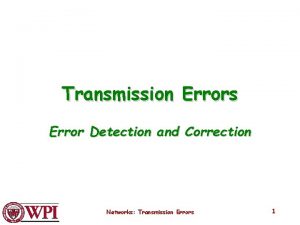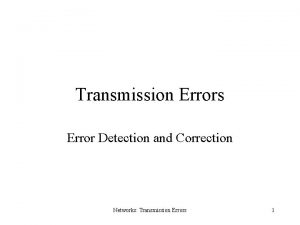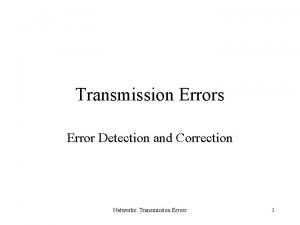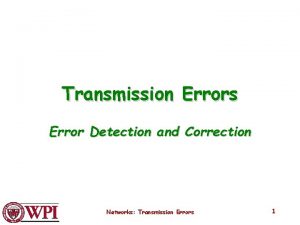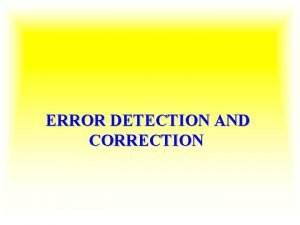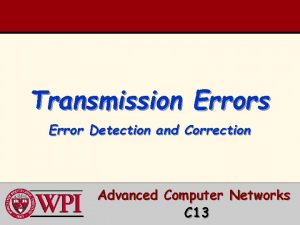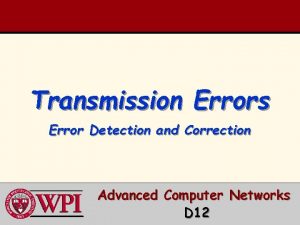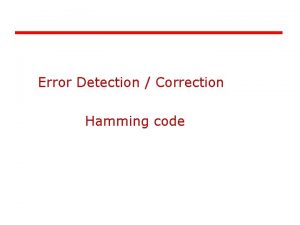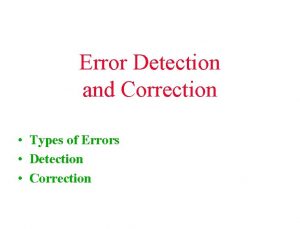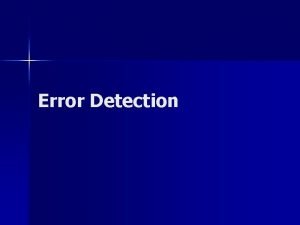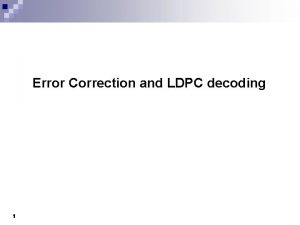Transmission Errors Error Detection and Correction Computer Networks





























- Slides: 29

Transmission Errors Error Detection and Correction Computer Networks Spring 2013

Transmission Errors Outline Error Detection versus Error Correction § Hamming Distances and Codes § Linear Codes - Parity § Internet Checksum § Polynomial Codes § Cyclic Redundancy Checking (CRC) § Properties for Detecting Errors with Generating Polynomials § Computer Networks Transmission Errors 2

Transmission Errors § Transmission errors are caused by: – thermal noise {Shannon} – impulse noise (e. . g, arcing relays) – signal distortion during transmission (attenuation) – crosstalk – voice amplitude signal compression (companding) – quantization noise (PCM) – jitter (variations in signal timings) – receiver and transmitter out of synch. Computer Networks Transmission Errors 3

Error Detection and Correction error detection : : adding enough “extra” bits (redundancy) to deduce that there is an error but not enough bits to correct the error. § If only error detection is employed in a network transmission a retransmission is necessary to recover the frame (data link layer) or the packet (network layer). § At the data link layer, this is referred to as ARQ (Automatic Repeat re. Quest). § Computer Networks Transmission Errors 4

Error Detection and Correction error correction : : requires enough additional redundant bits to deduce what the correct bits must have been. Examples § Hamming Codes § FEC = Forward Error Correction found in MPEG-4 for streaming multimedia. § Computer Networks Transmission Errors 5

Hamming Codes codeword : : a legal dataword consisting of m data bits and r redundant bits. Error detection involves determining if the received message matches one of the legal codewords. Hamming distance : : the number of bit positions in which two bit patterns differ. Starting with a complete list of legal codewords, we need to find the two codewords whose Hamming distance is the smallest. This determines the Hamming distance of the code. Computer Networks Transmission Errors 6

Error Correcting Codes Note Check bits occupy power of 2 slots Figure 3 -7. Use of a Hamming code to correct burst errors. Tanenbaum Computer Networks Transmission Errors 7

Hamming Distance (a) A code with poor distance properties o o x x x o o o x = codewords (b) A code with good distance properties o x x o o o x x o = non-codewords Leon-Garcia & Widjaja: Communication Networks Computer Networks Transmission Errors 8

Hamming Codes § § è To detect d single bit errors, you need a d+1 code distance. To correct d single bit errors, you need a 2 d+1 code distance. In general, the price for redundant bits is too expensive to do error correction for network messages. Network protocols normally use error detection and ARQ. Computer Networks Transmission Errors 9

Error Detection Note - Errors in network transmissions are bursty. è The percentage of damage due to errors is lower. è It is harder to detect and correct network errors. § Linear codes § § – Single parity check code : : take k information bits and appends a single check bit to form a codeword. – Two-dimensional parity checks IP Checksum Polynomial Codes Example: CRC (Cyclic Redundancy Checking) Computer Networks Transmission Errors 10

General Error Detection System All inputs to channel satisfy pattern/condition User information Encoder Channel output Pattern Checking Deliver user information or set error alarm! Done by the receiver Leon-Garcia & Widjaja: Communication Networks Computer Networks Transmission Errors 11

Error Detection System Using Check Bits sent serially Received information bits Information bits Recalculate check bits Channel Calculate check bits Compare Received check bits Check bits Information accepted if check bits match Leon-Garcia & Widjaja: Communication Networks Computer Networks Transmission Errors 12

Two-dimensional Parity Check Code 1 0 0 0 1 1 0 0 Last column consists of check bits for each row 1 1 0 1 0 0 1 1 1 Bottom row consists of check bit for each column Leon-Garcia & Widjaja: Communication Networks Computer Networks Transmission Errors 13

Multiple Errors 1 0 0 0 0 0 1 1 0 0 One error 0 0 0 1 1 0 1 0 0 1 1 1 1 0 0 1 0 0 0 1 1 0 0 Three errors 1 0 0 1 1 0 0 0 1 1 0 0 1 1 1 Arrows indicate failed check bits Computer Networks Transmission Errors Two errors Four errors Leon-Garcia & Widjaja: Communication Networks 14

Internet Checksum Leon-Garcia & Widjaja: Communication Networks Computer Networks Transmission Errors 15

Polynomial Codes § § Used extensively. Implemented using shift-register circuits for speed advantages. Also called CRC (cyclic redundancy checking) because these codes generate check bits. Polynomial codes : : bit strings are treated as representations of polynomials with ONLY binary coefficients (0’s and 1’s). Computer Networks Transmission Errors 16

Polynomial Codes § The k bits of a message are regarded as the coefficient list for an information polynomial of degree k-1. I : : i(x) = i Example: k-1 xk-1 + i k-2 xk-2 + … + i x + i 1 0 i(x) = x 6 + x 4 + x 3 1 0 1 1 0 0 0 Computer Networks Transmission Errors 17

Polynomial Notation Encoding process takes i(x) produces a codeword polynomial b(x) that contains information bits and additional check bits that satisfy a pattern. § Let the codeword have n bits with k information bits and n-k check bits. § We need a generator polynomial of degree n-k of the form G = g(x) = xn-k + g xn-k-1 + … + g x + 1 § n-k-1 1 Note – the first and last coefficient are always 1. Computer Networks Transmission Errors 18

CRC Codeword k information bits n-k check bits n bit codeword Computer Networks Transmission Errors 19

Polynomial Arithmetic Addition: Multiplication: = q(x) quotient x 3 + x 2 + x Division: divisor x 3 + x + 1 ) x 6 + x 5 x 6 + x 4 + x 3 dividend x 5 + x 4 + x 3 x 5 + x 3 + x 2 x 4 + x 2 + x x = r(x) remainder Leon-Garcia & Widjaja: Communication Networks Computer Networks Transmission Errors 20

CRC Algorithm CRC Steps: 1) Multiply i(x) by xn-k (puts zeros in (n-k) low order quotient remainder positions) xn-ki(x) = g(x) q(x) + r(x) 2) Divide xn-k i(x) by g(x) 3) Add remainder r(x) to xn-k i(x) (puts check bits in the n-k low order positions): transmitted codeword b(x) = xn-ki(x) + r(x) Leon-Garcia & Widjaja: Communication Networks Computer Networks Transmission Errors 21

CRC Example Information: (1, 1, 0, 0) Generator polynomial: g(x) Encoding: x 3 i(x) x 3 + x 2 + x 1110 x 3 + x + 1 ) x 6 + x 5 x 6 + x 4 + x 3 1011 ) 1100000 1011 x 5 + x 4 + x 3 x 5 + 1110 1011 x 3 + x 2 x 4 + = = i(x) = x 3 + x 2 x 3 + x + 1 x 6 + x 5 x 2 + x x Transmitted codeword: b(x) = x 6 + x 5 + x b = (1, 1, 0, 0, 0, 1, 0) Computer Networks 1010 1011 010 Leon-Garcia & Widjaja: Communication Networks Transmission Errors 22

CRC Long Division Figure 2. 15 CRC Calculation using Polynomial Long Division P&D Computer Networks Transmission Errors 23

Generator Polynomial Properties for Detecting Errors GOAL : : minimize the occurrence of an error going undetected. Undetected means: E(x) / G(x) has no remainder. Computer Networks Transmission Errors 24

GP Properties for Detecting Errors 1. Single bit errors: e(x) = xi 0 i n-1 If g(x) has more than one non-zero term, it cannot divide e(x) 2. Double bit errors: e(x) = xi + xj 0 i < j n-1 = xi (1 + xj-i ) If g(x) is primitive polynomial, it will not divide (1 + xj-i ) for j-i 2 n-k 1 3. Odd number of bit errors: e(1) = 1 If number of errors is odd. If g(x) has (x+1) as a factor, then g(1) = 0 and all codewords have an even number of 1 s. Leon-Garcia & Widjaja: Communication Networks Computer Networks Transmission Errors 25

GP Properties for Detecting Errors i th position 4. Error bursts of length L: i e(x) = x i d(x) 000011 • L 0001101100 • • 0 error pattern d(x) where deg(d(x)) = L-1 g(x) has degree n-k; g(x) cannot divide d(x) if deg(g(x))> deg(d(x)) if L = (n-k) or less: all will be detected if L = (n-k+1) : deg(d(x)) = deg(g(x)) i. e. d(x) = g(x) is the only undetectable error pattern, fraction of bursts which are undetectable = 1/2 L-2 if L > (n-k+1) : fraction of bursts which are undetectable = 1/2 n-k Leon-Garcia & Widjaja: Communication Networks Computer Networks Transmission Errors 26

Standard Generating Polynomials Six generator polynomials that have become international standards are: CRC-8 = x 8+x 2+x+1 CRC-10 = x 10+x 9+x 5+x 4+x+1 CRC-12 = x 12+x 11+x 3+x 2+x+1 CRC-16 = x 16+x 15+x 2+1 CRC-CCITT = x 16+x 12+x 5+1 CRC-32 = x 32+x 26+x 23+x 22+x 16+x 12+x 11 +x 10+x 8+x 7+x 5+x 4+x 2+x+1 IEEE link-level protocol standard {in hardware adaptor} GCRC-32 = 10000010011000001110110110111 Computer Networks Transmission Errors 27

Basic ARQ with CRC Error-free packet sequence Information frames Packet sequence Transmitter Station A Receiver Control frames CRC Station B Header Information packet Header Control frame Information Frame Computer Networks CRC Leon-Garcia & Widjaja: Communication Networks Transmission Errors 28

Transmission Errors Summary Error Detection versus Error Correction § Hamming Distances and Codes § Parity § Internet Checksum § Polynomial Codes § Cyclic Redundancy Checking (CRC) § Properties for Detecting Errors with Generating Polynomials § Computer Networks Transmission Errors 29
 Error detection and correction in computer networks
Error detection and correction in computer networks Error detection and correction in computer networks
Error detection and correction in computer networks Crc in computer networks
Crc in computer networks Difference between error detection and error correction
Difference between error detection and error correction Error detection and correction in data link layer
Error detection and correction in data link layer Crc mechanism
Crc mechanism 해밍코드 인코더
해밍코드 인코더 Correct edc
Correct edc Analog and digital signals in computer networking
Analog and digital signals in computer networking Virtual circuit network
Virtual circuit network Classify computer networks based on transmission technology
Classify computer networks based on transmission technology Reliable transmission in computer networks
Reliable transmission in computer networks Error and suspense account
Error and suspense account Basestore iptv
Basestore iptv Trial balance to balance sheet
Trial balance to balance sheet Errors not revealed by control accounts
Errors not revealed by control accounts Error control in computer networks
Error control in computer networks Transmission errors
Transmission errors Transmission errors
Transmission errors Cointegration and error correction model
Cointegration and error correction model Vector autoregression
Vector autoregression Eror
Eror Udp error correction
Udp error correction Wifi error correction
Wifi error correction 4-step error correction procedure pecs
4-step error correction procedure pecs Iso good documentation practices
Iso good documentation practices Correction of error
Correction of error Pcm
Pcm Good documentation practices error correction
Good documentation practices error correction Correction of prior period error
Correction of prior period error



